For years I carried a Taurus Model 85, five shot with 4rds, because I didn't want a rd under the hammer. In recent years I have used a Smith & Wession 642 with 5rds, because it has no external hammer: should I go to 4rds for safety? Let me thank all those who reply, in advance for their thoughts and advice!
You are using an out of date browser. It may not display this or other websites correctly.
You should upgrade or use an alternative browser.
You should upgrade or use an alternative browser.
Safe or not safe?
- Thread starter leolb1
- Start date
Bill DeShivs
New member
For years you cheated yourself out of 1 round unnecessarily
Fully load the cylinder-on both guns.
Fully load the cylinder-on both guns.
bamaranger
New member
tale
There seems to be a steady confusion on carrying a modern, quality DA revolver with the hammer down on an empty chamber. I had the same conversation with a neighbor recently, and knew of one individual who carried their duty revolver in this condition, despite all coaching to the contrary.
As stated, load it up and worry not.
There seems to be a steady confusion on carrying a modern, quality DA revolver with the hammer down on an empty chamber. I had the same conversation with a neighbor recently, and knew of one individual who carried their duty revolver in this condition, despite all coaching to the contrary.
As stated, load it up and worry not.
In recent years I have used a Smith & Wession 642 with 5rds, because it has no external hammer: should I go to 4rds for safety?
Whether the hammer is concealed or not, makes no difference. As all have said, the Smith is safe to carry with all chambers loaded. And as Bill DeShivs noted, likewise for the Taurus.
Driftwood Johnson
New member
Howdy
The long, thin, angled part in this photo is the hammer block that Smith and Wesson has been putting into every one of their revolvers since 1944. It rides in an angled slot in the side plate. As you can see, with the trigger and hammer at rest, the upper tip sits between the hammer and the frame. Whether or not the firing pin is mounted on the hammer or in the frame, makes no difference. In this condition, the hammer cannot move forward enough for the firing pin to touch a primer in a cartridge under the hammer.
When either the trigger is pulled, or the hammer cocked, the rebound slide will be shoved back. The pin in the rebound slide will pull the hammer block down, clearing the space between the hammer and the frame, allowing the hammer to fall all the way.
This is the only way a modern S&W revolver can fire.
Unless some bozo has gone inside and removed the hammer block, in the mistaken idea that doing so will smooth out the trigger pull.
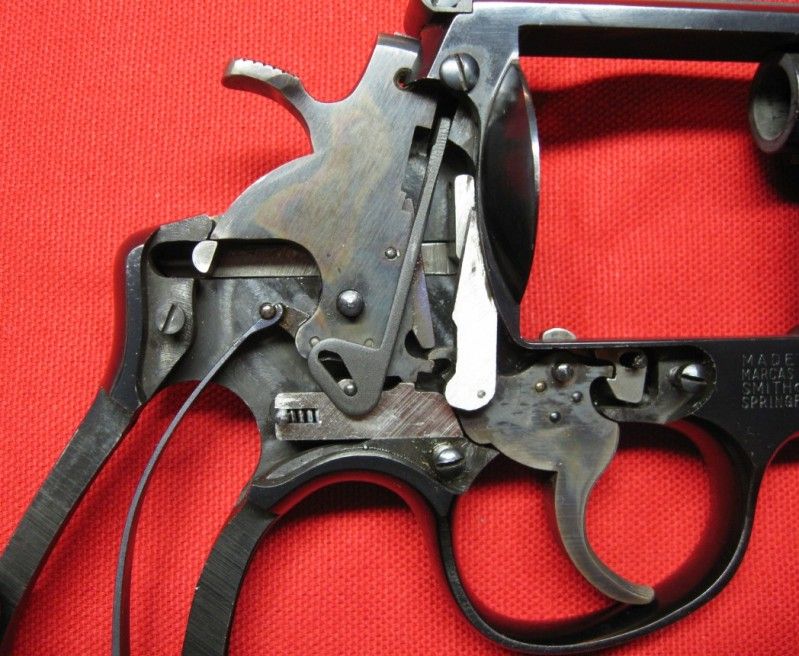
The long, thin, angled part in this photo is the hammer block that Smith and Wesson has been putting into every one of their revolvers since 1944. It rides in an angled slot in the side plate. As you can see, with the trigger and hammer at rest, the upper tip sits between the hammer and the frame. Whether or not the firing pin is mounted on the hammer or in the frame, makes no difference. In this condition, the hammer cannot move forward enough for the firing pin to touch a primer in a cartridge under the hammer.
When either the trigger is pulled, or the hammer cocked, the rebound slide will be shoved back. The pin in the rebound slide will pull the hammer block down, clearing the space between the hammer and the frame, allowing the hammer to fall all the way.
This is the only way a modern S&W revolver can fire.
Unless some bozo has gone inside and removed the hammer block, in the mistaken idea that doing so will smooth out the trigger pull.

Jim Watson
New member
Your Taurus has a transfer bar which operates the other way.
It does not move to couple the hammer to the frame mounted firing pin until the trigger is pulled.
So you were short changing yourself a round all that time.
The transfer bar has been making guns safe since Iver Johnson brought it out in 1896. Seen in all Ruger double actions, Ruger single actions since 1973, Colt Troopers after 1969, and a whole host of other "modern" revolvers.
It does not move to couple the hammer to the frame mounted firing pin until the trigger is pulled.
So you were short changing yourself a round all that time.
The transfer bar has been making guns safe since Iver Johnson brought it out in 1896. Seen in all Ruger double actions, Ruger single actions since 1973, Colt Troopers after 1969, and a whole host of other "modern" revolvers.
The transfer bar has been making guns safe since Iver Johnson
"Hammer the Hammer"
Kreyzhorse
New member
As everyone has said, totally safe to carry a round under the hammer of either of those guns as well as all modern revolvers.
Onward Allusion
New member
Transfer bar = safe to carry with all chambers loaded.
Hammer w/firing pin built in are generally not safe to carry with hammer resting on loaded chamber. However, some revolvers have the half-cock (not really HALF but more like 1/4") notch and some folks will carry that way on a loaded chamber. To cause even more confusion, some of these guns with the firing pin on the hammer still have a transfer bar.
Personal preference and also depends on the gun...
Hammer w/firing pin built in are generally not safe to carry with hammer resting on loaded chamber. However, some revolvers have the half-cock (not really HALF but more like 1/4") notch and some folks will carry that way on a loaded chamber. To cause even more confusion, some of these guns with the firing pin on the hammer still have a transfer bar.
Personal preference and also depends on the gun...
OldMarksman
Staff
Are you that you did not mean to say "hammer block"?To cause even more confusion, some of these guns with the firing pin on the hammer still have a transfer bar.
Driftwood Johnson
New member
Hammer w/firing pin built in are generally not safe to carry with hammer resting on loaded chamber.
Howdy Again
As I said earlier, whether or not the firing pin is mounted on the hammer or in the frame, has nothing to do with whether or not a revolver is safe to carry with a live round under the hammer.
The S&W 44 Hand Ejector, 4th Model in the photo I posted in post #10 has the firing pin in the hammer, as does every S&W revolver made from 1899 on and up to very recently. Any S&W revolver made after 1944 is safe to carry fully loaded because it has the modern hammer block in it, whether or not the firing pin is mounted to the hammer or mounted in the frame.
The very earliest S&W Hand Ejectors, starting in 1896 were not safe to carry fully loaded, because despite the rebounding hammer, they had no hammer block inside. This is a photo of the interior of an early S&W 38 Military and Police revolver. This gun had the same basic rebounding hammer that S&W has put into all their revolvers since 1905. You can see the hump on top of the rebound slide has wedged the hammer back from the frame, withdrawing the firing pin from contact with the primer of a round under the hammer. At first it was thought this was safe enough. However, S&W later decided to add a hammer block as a redundant safety mechanism once it was discovered that a forceful blow to the hammer spur could cause the hammer to fracture where I drew the red line, causing the hammer to move forward forcefully, possibly firing a live round under the hammer.
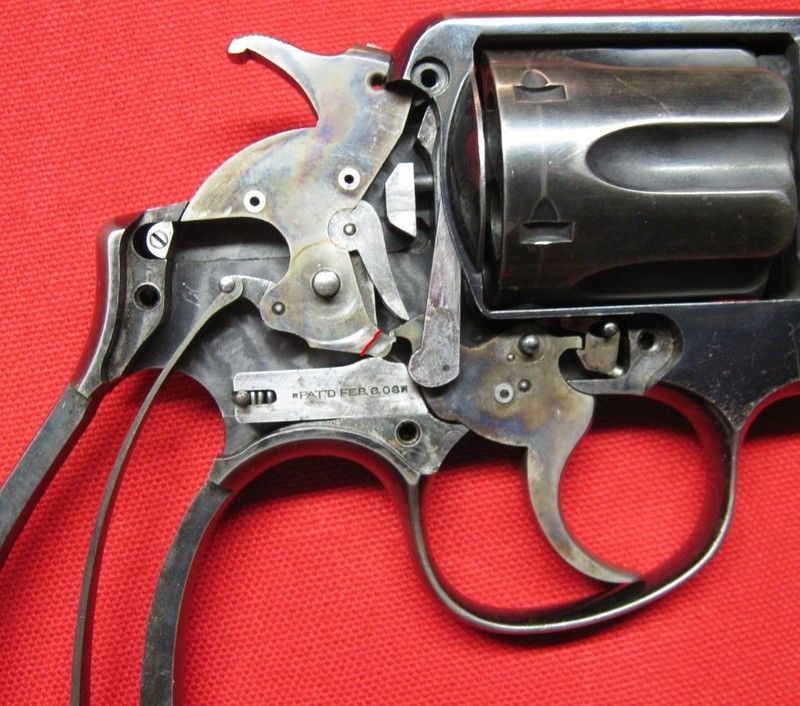
This 38 M&P Target Model left the factory in 1917. It has the first type of hammer block that S&W installed in their revolvers. There is still a hump on top of the rebound slide, wedging the hammer back from the frame. The hammer block is a piece of spring steel pressed into a slot in the side plate. There is an ear on the hammer block projecting towards us in this view. Normally, the ear of the hammer block was positioned between the hammer and the frame, preventing the hammer from moving forward if the hammer spur was struck with a massive blow and something broke. There is a spring loaded pin in the side plate that activates the hammer block. An angled surface on the hand pushes the pin in whenever the hammer is cocked or the trigger is pulled. This withdraws the hammer block into the side plate, allowing the hammer to fall all the way. When the trigger is released and the hand moves down, the hammer block springs back into position blocking the hamemr.
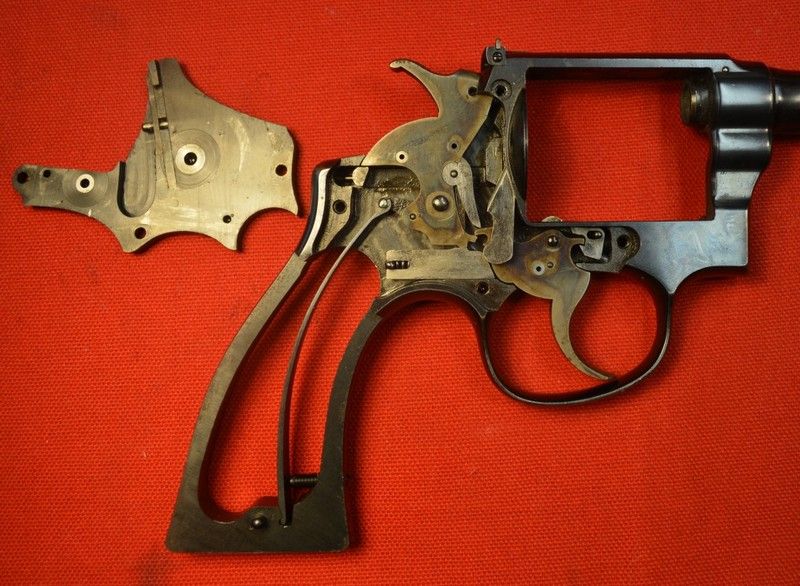
This is the second type of hammer block S&W installed in their revolvers. This particular 38 M&P left the factory in 1939. The hammer block is still a piece of spring steel staked into the side plate, but there is no longer a spring loaded pin to activate it. Instead, a ramp on the hand pushes against a tab on the hammer block as the hand rises. This withdraws the hammer block into the side plate, in a manner similar to the earlier style of hammer block. This style of hammer block has less moving parts and was probably less expensive to produce than the first style.
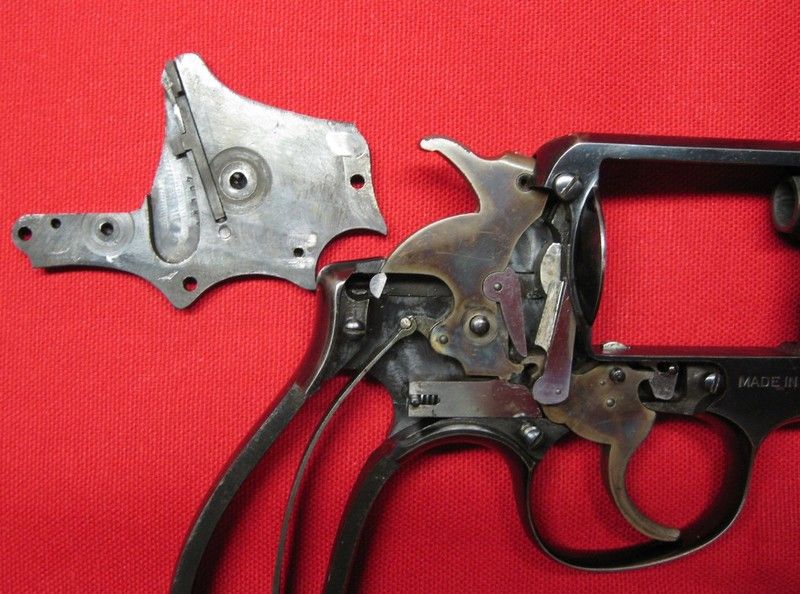
In 1944 a sailor was killed when a 38 Victory Model with the second style of hammer block discharged when it fell to the deck of a warship. I have no information on how far the pistol fell before striking the deck, but this incident is well documented. The military ordered an investigation. The results were that as so often happens, the accident happened as a result of a cascade of events. It was determined that hardened grease inside the revolver most likely prevented the hammer block from springing back to the 'safe' position. And with the hammer block not functioning properly, when the hammer spur received a strong blow, something inside fractured, causing the fatal discharge. S&W was still supplying Victory Model revolvers to the military at this time. S&W was ordered to come up with a solution if they wanted to keep their lucrative contracts with the government. The engineering staff was called in and working night and day for one week they came up with the present design of hammer block, which has been installed in every S&W revolver ever since.
Single action revolvers are a completely different story.
This is a photo of the moving parts in a Colt Single Action Army. Although this one was made in the 1970s, the parts are basically the same as they were in 1873, and are basically the same in a revolver that leaves the Colt factory today. There are three notches on the hammer, the so called 'safety cock' notch, the half cock notch, and the full cock notch. The upper tip of the hammer is called the sear, the lower arrow is pointing to it. The sear pops into the various notches as the hammer is pulled back. The upper arrow is pointing to the 'safety cock' notch. Notice this notch and the half cock notch have a small lip projecting over the notches. This lip traps the sear so that the trigger cannot be pulled when the hammer is cocked to these respective positions. Notice how thin the sear is. This is the basic weakness of the Colt design. If the gun is fully loaded with six rounds, and it falls to the ground, and happens to land on the hammer, either the sear may fail or the 'safety cock' notch may fail, allowing the gun to discharge. The cross section of the parts is simply very thin and they are not very strong. This fact is well known to anyone familiar with these revolvers, and is why they are not safe to carry fully loaded with a live round under the hammer.
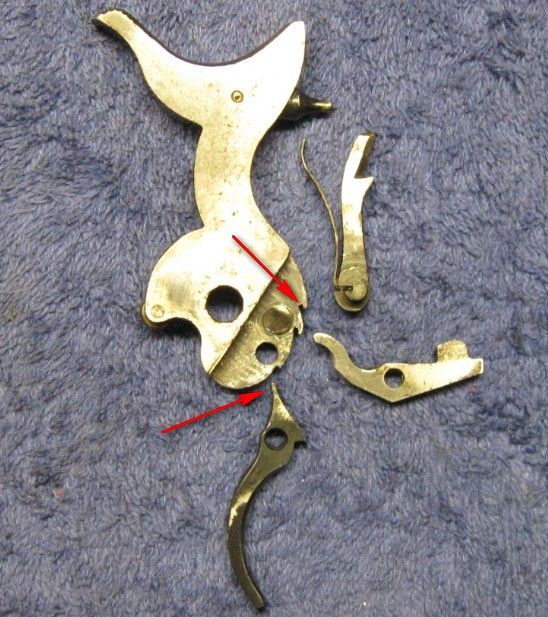
As a side note, single action revolvers based on the SAA design imported into this country from Europe are required by the Federal Government to have a second, redundant safety mechanism built into them to prevent a discharge if the gun falls to the ground. There are two styles of these redundant safety devices, one is built into the hammer and cannot be easily removed, the other is built into the cylinder pin and can very easily be replaced because it is a poor design. Uberti has come up with a third style of safety in their latest revolvers, but these have just recently hit the market. Colt is not required to have a redundant safety built into the Single Action Army.
This is the hammer from a Three Screw Ruger Blackhawk. Notice the firing pin is not mounted to the hammer. Notice too that the hammer has the same basic 'three notch' configuration as the hammer of the Colt. This style of Ruger suffered from the same weakness as the Colt, the sear or the 'safety notch' could shear if the gun fell onto its hammer.

As a result of several costly lawsuits, Ruger completely redesigned their line of single action revolvers in the early 1970s to include a transfer bar. Notice I said transfer bar, not hammer block. A transfer bar functions the opposite of a hammer block. A revolver equipped with a hammer block cannot fire unless the hammer block has moved from its normal 'safe' position. A revolver equipped with a transfer bar cannot fire unless the transfer bar is in position to transfer the blow of the hammer to the frame mounted firing pin.
This photo of a modern Ruger Vaquero shows the transfer bar in position to transfer the blow of the hammer to the frame mounted firing pin.
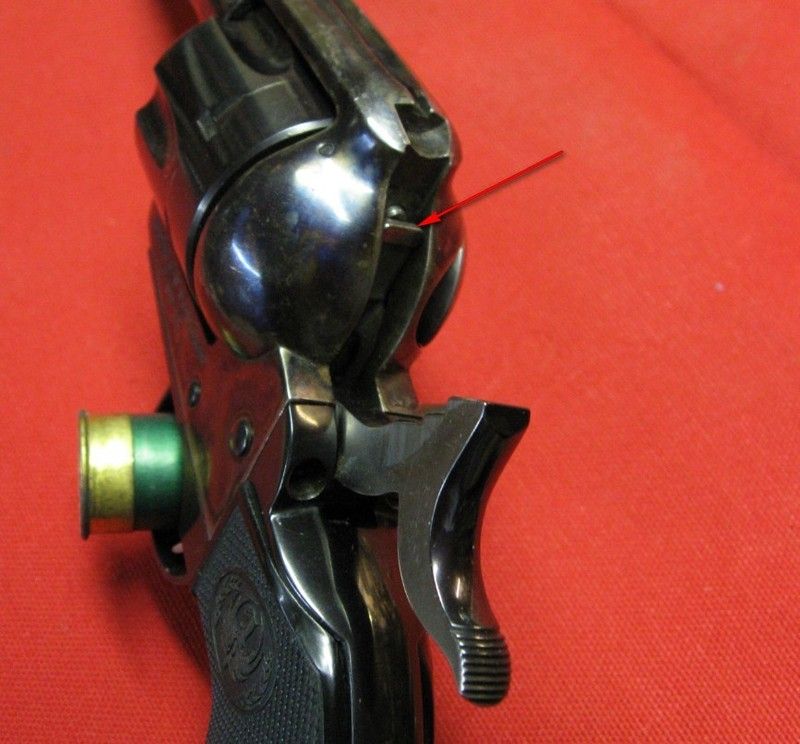
I would show photos of the lockwork of some other brands of single action revolvers from the 19th Century, to show how they too were unsafe to carry fully loaded, but this forum only alows six photos to be attached to any post.
Regardless, the presence or lack of a firing pin on the hammer has nothing to do with how safe a revolver is to carry fully loaded.
Also, even without the modern hammer block inside a S&W revolver, the design was still less 'accident prone' than the old single action revolvers. In redesigning the hammer block in 1944, S&W did extensive tests, dropping guns onto a hard surface, and determined that the internal parts could fracture. Based on this, some believe that a S&W from before 1944 should never be carried fully loaded. I tend to disagree with this somewhat. The S&W design was still more robust than the old Single Action designs. I would never dream of carrying a Single Action Army fully loaded. I do on occasion load up an old S&W fully, and countless police officers did so for generations.
Last edited:
Driftwood Johnson
New member
A few more photos of single action revolver mechanisms.
This is the lockwork of a S&W Russian Model revolver. Although the mechanism functions very differently than the mechanism of a Colt, there are a few similarities.
In this photo, the hammer is cocked, ready to fire. The sear is in the full cock notch.

In this photo, the hammer is in the loading position. The sear is in a notch similar to the 'safety cock' notch of the Colt, but it is called the half cock notch on this gun. Notice there is an overhanging lip on the notch, preventing the trigger from being pulled. The hammer must be in this position or the gun cannot be broken open to load or unload. The knurled piece at the top of the frame is the latch to open the frame for loading. Notice there is a slot in the hammer, and a tab projecting back from the latch. With the hammer in this position, the slot on the hammer clears the tab on the latch, and the latch can be pivoted up to allow the gun to be broken open. In this position, a strong blow to the hammer could possibly shear the sear or the hammer notch, allowing the gun to discharge.
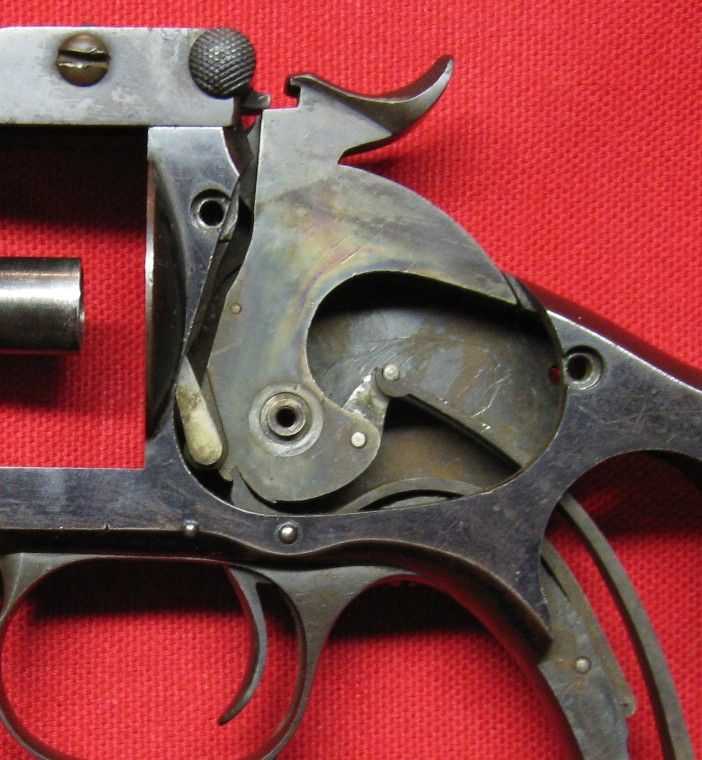
This photo shows the hammer fully down, in the position it would be after the gun fired. The sear is clear of the half cock notch, and the slot on the hammer is blocking the tab on the latch. To fire again you cock the hammer again. To reload you must pull the hammer back to half cock to free the latch.

This is the lockwork of a Merwin Hulbert single action revolver. Although the Merwin Hulbert is often touted as the most advanced design of 19th Century revolvers, the lockwork works exactly the same as the S&W Russian model and Schofield model. In this photo, the hammer is in the loading position, with the sear nestled in the half cock notch. A strong blow to the hammer of this revolver might also break something, resulting in a live round under the hammer discharging.
Regarding 'the most advanced design', notice how much more crudely the hammer notches are cut onto the MH hammer than the S&W hammer. So much for 'the most advanced' design.
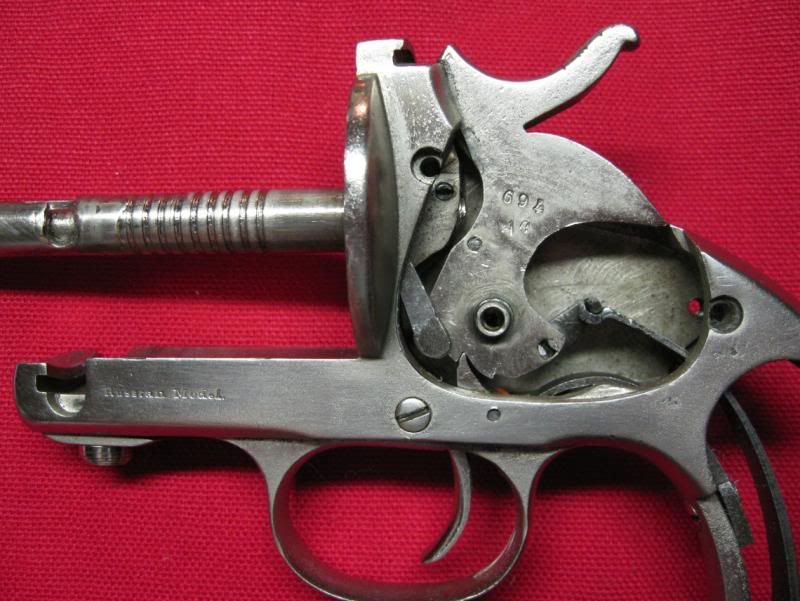
This is the most advanced design of 19th Century single action revolvers, the S&W New Model #3. This revolver was built with a rebounding hammer. Working clockwise from the bottom of the hammer are the full cock notch, the half cock (loading position) notch, and the tiny notch that the sear rested in when the hammer was at rest.
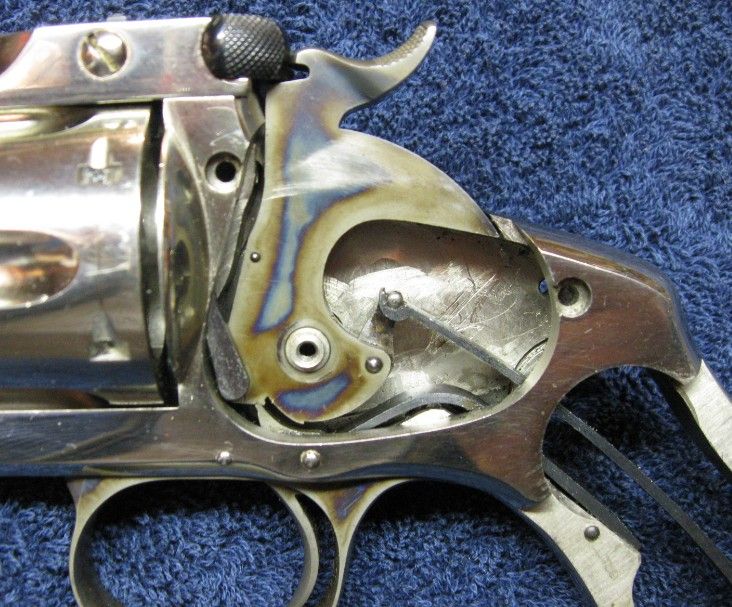
In this photo I am pushing the hammer forward, as it would be at the moment the firing pin strikes a cartridge. You can see the sear is clear of all three notches on the hammer. As soon as the gun fires, the geometry of the hammer spring will rock the hammer back, popping the sear into the tiny 'resting position' notch on the hammer.
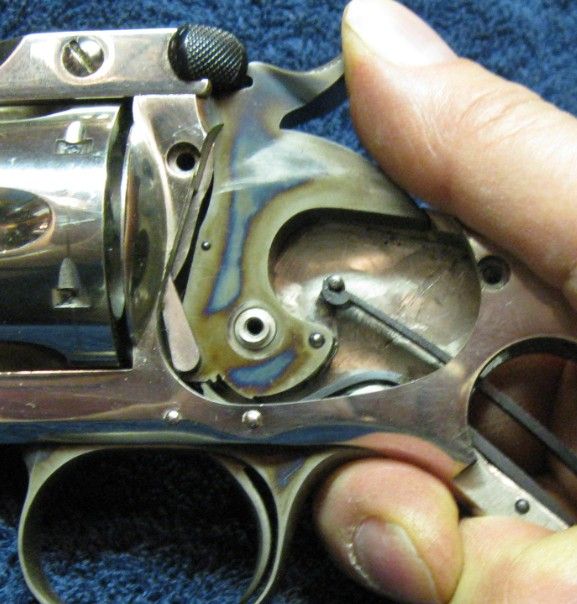
That is my limit of six photos per post.
You can see that none of these revolvers was safe to carry fully loaded with a live round under the hammer because of the possibility of parts breaking if the gun fell on its hammer.
This is the lockwork of a S&W Russian Model revolver. Although the mechanism functions very differently than the mechanism of a Colt, there are a few similarities.
In this photo, the hammer is cocked, ready to fire. The sear is in the full cock notch.

In this photo, the hammer is in the loading position. The sear is in a notch similar to the 'safety cock' notch of the Colt, but it is called the half cock notch on this gun. Notice there is an overhanging lip on the notch, preventing the trigger from being pulled. The hammer must be in this position or the gun cannot be broken open to load or unload. The knurled piece at the top of the frame is the latch to open the frame for loading. Notice there is a slot in the hammer, and a tab projecting back from the latch. With the hammer in this position, the slot on the hammer clears the tab on the latch, and the latch can be pivoted up to allow the gun to be broken open. In this position, a strong blow to the hammer could possibly shear the sear or the hammer notch, allowing the gun to discharge.

This photo shows the hammer fully down, in the position it would be after the gun fired. The sear is clear of the half cock notch, and the slot on the hammer is blocking the tab on the latch. To fire again you cock the hammer again. To reload you must pull the hammer back to half cock to free the latch.

This is the lockwork of a Merwin Hulbert single action revolver. Although the Merwin Hulbert is often touted as the most advanced design of 19th Century revolvers, the lockwork works exactly the same as the S&W Russian model and Schofield model. In this photo, the hammer is in the loading position, with the sear nestled in the half cock notch. A strong blow to the hammer of this revolver might also break something, resulting in a live round under the hammer discharging.
Regarding 'the most advanced design', notice how much more crudely the hammer notches are cut onto the MH hammer than the S&W hammer. So much for 'the most advanced' design.

This is the most advanced design of 19th Century single action revolvers, the S&W New Model #3. This revolver was built with a rebounding hammer. Working clockwise from the bottom of the hammer are the full cock notch, the half cock (loading position) notch, and the tiny notch that the sear rested in when the hammer was at rest.

In this photo I am pushing the hammer forward, as it would be at the moment the firing pin strikes a cartridge. You can see the sear is clear of all three notches on the hammer. As soon as the gun fires, the geometry of the hammer spring will rock the hammer back, popping the sear into the tiny 'resting position' notch on the hammer.

That is my limit of six photos per post.
You can see that none of these revolvers was safe to carry fully loaded with a live round under the hammer because of the possibility of parts breaking if the gun fell on its hammer.
Last edited:
